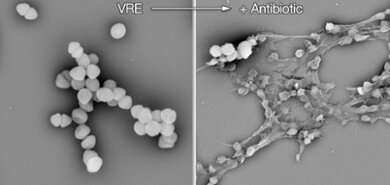
Globally, the number of deaths from infections is on the rise as more bacteria become resistant to antibiotics. New classes are desperately needed. A promising resistance inhibitor is now being developed by the research group of Nathaniel Martin, Professor of Biological Chemistry. Inaugural speech on 13 September.
The numbers are alarming: globally, around 700,000 patients die from infections that could have been treated with antibiotics in the 1970s and 1980s. But more and more bacterial strains are becoming resistant. The cause: the mass and often incorrect use of antibiotics and too few new classes of these drugs. “Without serious investment and innovation, by the year 2050 antibiotic resistance may claim as many as 10 million lives per year,” Martin warns.
Inhibiting resistance
With his Leiden research group, Martin is working on a promising solution that might be able to fight the resistance mechanisms of bacteria. The researchers have developed a new class of molecule inhibitors that block aggressive resistance enzymes. Lab studies have shown that, when combined with these new inhibitors, conventional antibiotics are able to kill resistant bacteria. Martin recently applied for a patent for this innovative method. Further studies with these inhibitors will follow soon. “Exciting times!” says Martin.
Less toxic
Martin is also using organic chemistry to structurally modify conventional antibiotics and make them safer and more effective. His research group has managed to reduce the toxicity of a certain class of antibiotics, the polymyxins. Martin: “The polymyxins are very important antibiotics because they are among the few options that doctors still have when treating certain multi-drug resistant infections.”
No longer a priority for the pharmaceutical industry
Despite the crucial role of antibiotics, only three large pharmaceutical companies are developing new antibiotics. The vast majority of antibiotics were discovered between the mid-1940s and the beginning of the 1970s. In this period, many natural antibiotics—generally antibacterial substances that are found in soil—were found that were relatively easy to turn into medicines. As the development of antibiotics became more difficult, the focus of the pharmaceutical industry began to shift to other diseases such as cancer.
Incentives needed
Source: Read Full Article
